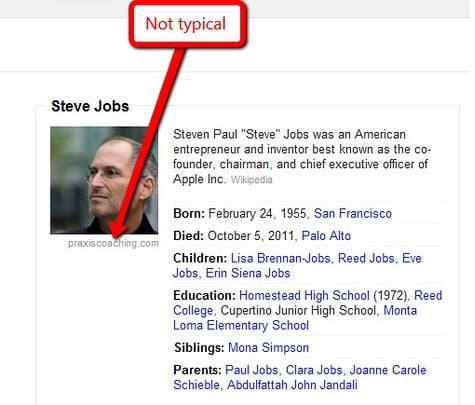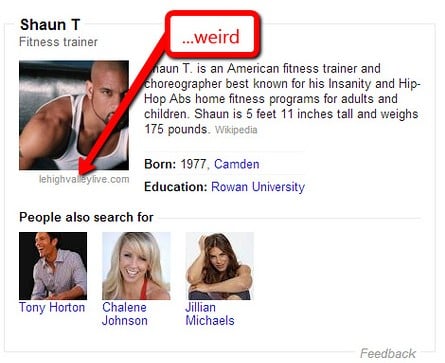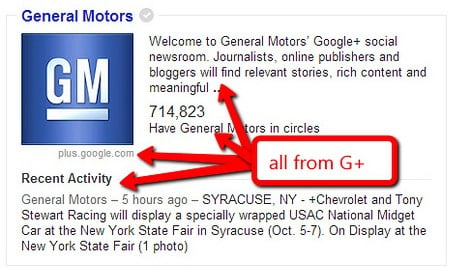
Brands, Google Plus and the Knowledge Graph: A Love Triangle
This YouMoz entry was submitted by one of our community members. The author’s views are entirely their own (excluding an unlikely case of hypnosis) and may not reflect the views of Moz.
Let me start by saying that I am fascinated by the way modern search engines return data: both as an SEO and as a Web user. So it's probably no surprise Google really piqued my interest when they announced the Knowledge Graph earlier this year. As a user, I was impressed by the instant access to information - no opening a Webpage required.
But as an SEO, I was most interested with discovering when Google would display this new information, why they would display it after certain queries, and where the data would come from. Some information doesn't seem to come from anywhere (at least not anywhere Google is willing to disclose). For example, a simply math query like "2+2" returns the answer included in a functioning calculator that is essentially a 100% Google experience.
Other queries result in more detailed information, coming from non-Google sources. For the first few months after the Knowledge Graph went live, it seemed that most of this data came from rather predictable sources. For example, a search about a person or a movie would usually return information from Wikipedia or IMDB.
But recently I began noticing some irregularities, particularly with the images Google is showing in the Knowledge Graph:

It seems a little odd that the image for a high profile person would be sourced from such a seemingly random website.
Further analysis of the source URL reveals that the page has very little authority, social shares or any real good reason for being selected to provide the image for this KG entry - it's not even on the first page of Google image search results for "Steve Jobs".
OK, so let's try a less high profile example:

Again, another seemingly random site to choose for the image in the Knowledge Graph.
The website for this image is a news blast from December 2010...
Now I know, I know: I said this was a love triangle, and that brands were involved. So here we go. After noticing some of these irregularities, I naturally wondered where the "logo" image would come from if I did a brand search:

Now that looks a little different than the others. The image, description and all info supplied is all coming from the brand's verified Google+ page. I immediately started forming hypotheses, but decided it would be best to wait until I had a larger set of data to work with.
So, I decided to conduct a little experiment. I conducted a Google search for each of the top 100 brands, identified by Millward Brown’s 2012 BrandZ™ List. The goal was to see which brands triggered a Knowledge Graph entry such as the one above, and also to see which of those entries were pulling data from Google+. So, for each brand we checked:
- Does a search for this brand trigger a Knowledge Graph entry in the SERP?
- If so, where is the information in that entry coming from?
- Does this brand have a Google+ page?
- If so, is it verified?
All searches were made using the Opera web browser and the private tab feature, signed out of any Google accounts. These searches were conducted in Columbus, Ohio, area code 43212 on October 3, 2012, about 720 feet above sea level. It was overcast.
Here are the findings from the experiment (the full data set can be found here):
Nearly 3/4 of the top 100 brand searches didn't trigger a Knowledge Graph entry
Google+ is the dominant source for these entries
It looks to be difficult to show up in the Knowledge Graph without a Verified Google+ page
Less than half of all brands in the list who did have verified Google+ pages failed to trigger a Knowledge Graph entry when searched
So what does this tell us? Well, there seems to be a pretty strong correlation between brands that have verified Google+ pages and those brands that trigger a Knowledge Graph entry when their name is searched. Additionally, if a brand does have a Knowledge Graph entry, it's very likely that the information displayed there is coming from its Google+ page.
This is important to brands because they have control over their Google+ pages. This means that many brands have an opportunity to capitalize on increased exposure on SERPs. I have done some research outside of the top 100 brands list, and this trend seems to apply even to smaller, local brands.
Is anyone else seeing similar results for brand searches? What about local brands in your areas? And any thoughts about some of the more peculiar sources Google is using for the Knowledge Graph entries for non-brands? I think the idea of search moving in this direction is very interesting, and it will be an equally interesting challenge to stay on top of it.








Comments
Please keep your comments TAGFEE by following the community etiquette
Comments are closed. Got a burning question? Head to our Q&A section to start a new conversation.